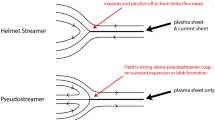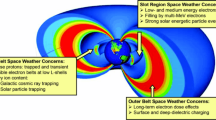Abstract
The 9.85-GHz (3.04 cm) line of atomic hydrogen due to the 22P3/2–22S1/2 transition between levels of the hyperfine structure occupies a special place in the complex spectrum of the Sun. This is essentially the only hydrogen line that is expected in the solar radio spectrum. The promising nature of solar observations in the H3.04 line was first noted in 1952 by Wild, who calculated the line profile using a model for the “quiet” Sun characterized by a weak magnetic field (several Gauss). Computations of this line profile taking into account the strong magnetic fields in solar active regions (hundreds Gauss) are considered here. It is shown that the Zeeman effect leads to appreciable changes in the appearance of the line profile. This may help explain why searches for the H3.04 line have not led to any detections earlier. New observations of the Sun on the RATAN-600 telescope are analyzed with allowance for the Zeeman effect.
Similar content being viewed by others
References
J. P. Wild, Astrophys. J. 115, 206 (1952).
A. Zelenka, Solar Phys. 58, 17 (1978).
C. De Jager, in Paris Symposium on Radio Astronomy, Ed. by R. N. Bracewell (Stanford Univ. Press, Stanford, 1959), p. 96.
A. F. Dravskikh, Izv. GAO 164, 128 (1960).
A. F. Dravskikh, Izv. GAO 172, 40 (1964).
A. F. Dravskikh and Z. V. Dravskikh, Preprint SAO AN SSSR No. 42L (SAO RAN, Zelenchuk, 1987).
A. F. Dravskikh and Z. V. Dravskikh, Sov. Astron. 32, 104 (1988).
V. M. Bogod, A. M. Alesin, and A. A. Pervakov, Astrophys. Bull. 66, 205 (2011).
N. A. Topchilo, N. G. Peterova, and T. P. Borisevich, Astron. Rep. 54, 69 (2010).
V. M. Bogod and L. V. Yasnov, Solar Phys. 291, 3317 (2016).
C. Alissandrakis, V. Bogod, T. Kaltman, and N. Peterova, in Proceedings of the CESRA 2016: Solar Radio Physics from the Chromosphere to Near Earth, WG 3: Fine Structures and Radio Wave Propagation, June 13–17, 2016, Orléans, France.
S. E. Frish, Optical Spectra of Atoms (Fizmatgiz, Moscow, 1963) [in Russian].
T. J. Okamoto and T. Sakurai, Astrophys. J. Lett. 852, L16 (2018).
B. P. Filippov and O. E. Den, Astron. Rep. 62, 359 (2018).
Author information
Authors and Affiliations
Corresponding authors
Additional information
Russian Text © A.F. Dravskikh, N.G. Peterova, N.A. Topchilo, 2019, published in Astronomicheskii Zhurnal, 2019, Vol. 96, No. 3, pp. 246–254.
Rights and permissions
About this article
Cite this article
Dravskikh, A.F., Peterova, N.G. & Topchilo, N.A. Profile of the 9.85-GHz Neutral Hydrogen Line Taking into Account the Zeeman Effect (Computations and Solar Observations). Astron. Rep. 63, 229–237 (2019). https://doi.org/10.1134/S1063772919030028
Received:
Accepted:
Published:
Issue Date:
DOI: https://doi.org/10.1134/S1063772919030028




